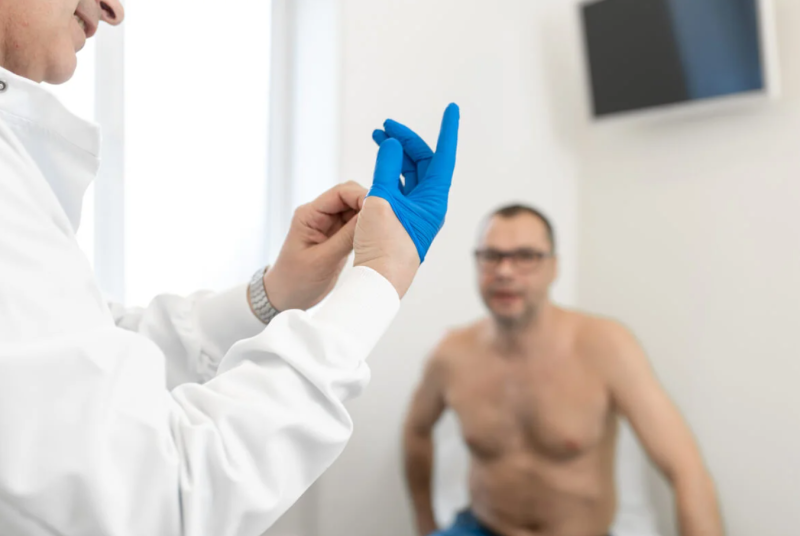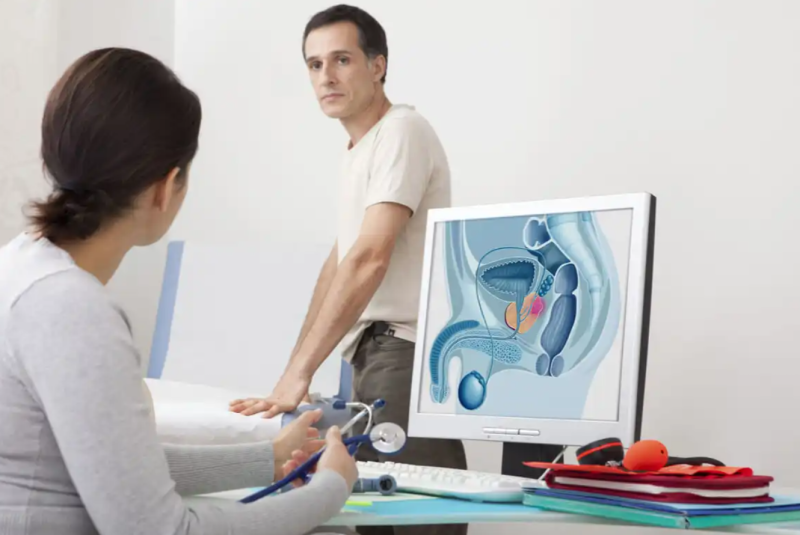
Prostate massage is a procedure in which a finger or a massaging object is inserted through the rectum to stimulate this fibromuscular and glandular organ that produces seminal fluid. Prostate massage aims to release excess seminal fluid from the gland.
By this mechanism, prostate massage helps to improve inflammation and relieve its pressure on the urinary tract. It would be helpful in benign prostatic hyperplasia, chronic bacterial prostatitis, painful pelvic syndrome, urinary retention, and erectile dysfunction.
It is also used for sexual stimulation, helping to achieve arousal. During the sexual act, it improves the erection and relaxes the rectum before anal sex.
Contents
What is the organ involved in prostate massage?
Prostate massage is performed on the prostate. The prostate is a male sexual organ located in the pelvis, behind the pubis, in front of the rectum, and below the bladder.
It surrounds the urethra just at its exit, below the neck of the bladder. That is why its growth generates urinary tract obstruction with consequent urinary symptoms.
Its shape is an inverted pyramid, and its size varies with age. In a healthy young adult, it is compared to the size of a walnut and weighs approximately 20 grams. As age increases, the prostate grows in size in benign prostatic hyperplasia.
This organ is part of the urinary and reproductive systems. It participates fundamentally in the production of seminal fluid, which is part of the semen and provides the environment and nutrients for the survival of spermatozoa.
Some diseases are associated with improvement in symptoms after prostate stimulation. Let’s see what they are.
Benign prostatic hyperplasia
This disorder is the benign growth of the prostate that occurs with advancing age. Its symptoms are as follows:
- Increased micturition frequency during the night.
- Difficulty initiating urination.
- Weak urinary stream.
- Postvoid dribbling.
- Impossibility of complete emptying of the bladder.
When not treated early, the disorder can lead to urinary incontinence, sexual dysfunction, and acute or chronic inflammation (prostatitis). In addition, it is associated with an increase in the frequency of urinary infections. However, it does not have any risk related to prostate cancer.
Chronic bacterial prostatitis
Chronic bacterial prostatitis is caused by the persistence of bacteria in the urinary tract. There are usually asymptomatic episodes alternating with symptoms similar to benign prostatic hyperplasia.
Chronic painful pelvic syndrome
In this syndrome, there is a pain in the perineum, above or below the pubis, in the penis, scrotum, or inguinal region. The discomfort can be continuous or intermittent. It is associated with erectile dysfunction and symptoms similar to benign prostatic hyperplasia.
How is a prostate massage performed?
Prostate massage is performed by inserting one or two fingers through the rectum. These fingers must be sheathed in a previously lubricated latex or nitrile glove.
Or a prostate massager or other medical instrument can be used. The sides of the lobe of the prostate are massaged, and then the center, without vigorously pressing the nerve plexus.
And what about prostate massage for sexual purposes?
In this case, to perform the prostate massage, wash your hands correctly, keep your nails short to avoid abrasions, and apply water-based or silicone-based lubricant.
To have greater sexual arousal and enhance orgasm, it is sought through digital stimulation (or with a massager) to move the gland up and down. At the same time, the penis is stimulated.
The prostate massager is an instrument specifically designed for this. That is why its shape is similar to that of a finger and has a smooth curvature that allows it to reach the gland effectively.Has prostate massage been shown to be beneficial?
A 2009 study of 115 men found that manual or device prostate massage, performed by a physician or at home, has potential benefits in improving organ inflammation and associated symptoms. Also, it is believed to enhance ejaculation intensity (but does not affect erectile dysfunction).
However, in a previous study carried out in 2006 with 81 patients, it was described that there was no significant response in improving symptoms, especially in cases of chronic pelvic pain syndrome. That is why more analytical research is required to establish the associated risks.
Prostate massage in medical practice
When performed by a doctor, prostate massage can reduce the inflammation of chronic bacterial prostatitis in conjunction with antibiotics. In addition, because it contributes to the discharge of fluids without the need for orgasms or ejaculation, it is used to obtain seminal fluid for culture in case of suspected bacterial prostatitis.
Possible risks
Because the tissue surrounding the prostate and rectum is delicate when prostate massage is performed too frequently or intensely, it can lead to fissures, abrasions, pain, or discomfort; on the other hand, it can worsen hemorrhoid symptoms, increase the risk of infections, or cause bleeding.
It would also affect a man’s sexual capacity since the prostate is covered by a nerve plexus that connects to the hollow body of the penis. Vigorous stimulation can affect the ability to maintain an erection and cause pain.

Contraindications of prostate massage
Prostate massage should not be performed in men with acute bacterial prostatitis because it increases inflammation and favors the spread of the infection. This could cause bacteria to reach the urethra and travel to the kidneys.
Furthermore, it should not be performed in cases of suspected prostate cancer since there is a greater risk of metastasis, neither before a urological evaluation nor taking a sample for prostate antigen because the stimulation can cause a false positive.
A safe practice, if done with professionals
Prostate massage is effective in sexual practices to increase arousal and orgasm intensity. From a medical point of view, it improves the symptoms of chronic bacterial prostatitis and benign prostatic hyperplasia.
However, more studies are required on the medical benefits of doing it at home. It is necessary to consider its possible risks, contraindications and not abuse the frequency and intensity of its practice.